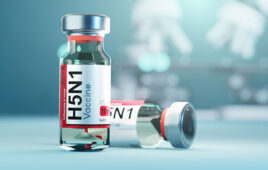 Merck today announced that the U.S. Food and Drug Administration (FDA) has approved Noxafil (posaconazole) 100 mg delayed-release tablets. Noxafil delayed-release tablets are a new formulation with a loading dose of 300 mg (three 100 mg delayed-release tablets) twice daily on the first day, followed by a once-daily maintenance dose of 300 mg (three 100 mg delayed-release tablets) starting on the second day of therapy. Merck also markets Noxafil (40 mg/mL) oral suspension, which is dosed three times daily.
Merck today announced that the U.S. Food and Drug Administration (FDA) has approved Noxafil (posaconazole) 100 mg delayed-release tablets. Noxafil delayed-release tablets are a new formulation with a loading dose of 300 mg (three 100 mg delayed-release tablets) twice daily on the first day, followed by a once-daily maintenance dose of 300 mg (three 100 mg delayed-release tablets) starting on the second day of therapy. Merck also markets Noxafil (40 mg/mL) oral suspension, which is dosed three times daily.Noxafil delayed-release tablets and oral suspension are indicated for the prophylaxis of invasive Aspergillus and Candida infections in patients, 13 years of age and older, who are at high risk of developing these infections due to being severely immunocompromised, such as hematopoietic stem cell transplant (HSCT) recipients with graft-versus-host disease (GVHD) or those with hematologic malignancies with prolonged neutropenia (low white blood cell counts) from chemotherapy.
“Prophylaxis against invasive Aspergillus and Candida infections plays a key role in the management of severely immunocompromised patients with hematologic malignancies or hematopoietic stem cell transplant recipients who are at high risk for these life-threatening fungal infections,” said Daniel Couriel, MD, professor of internal medicine and clinical program director, adult blood and marrow transplantation program, University of Michigan Comprehensive Cancer Center. “Posaconazole delayed-release tablets offer physicians a way to help protect these critically ill patients against invasive Aspergillus and Candida infections while they are in the hospital and once they return home.”
FDA approval of Noxafil (posaconazole) delayed-release tablets based on a pharmacokinetic study in patients.
A non-comparative, multicenter study was performed to evaluate the pharmacokinetic properties, safety and tolerability of Noxafil delayed-release tablets in patients with acute myeloid leukemia (AML) or myelodysplastic syndrome (MDS) who had developed or were anticipated to develop significant neutropenia, and in patients who had undergone HSCT and were receiving immunosuppressive therapy for prevention or treatment of GVHD. In the study, exposures of posaconazole within a prespecified range were attained. The exposure levels achieved support a 300 mg (three 100 mg delayed-release tablets) once-daily dose of Noxafil delayed-release tablets, following a 300 mg (three 100 mg delayed-release tablets) twice-a-day loading dose on the first day of therapy. The most frequently reported adverse reactions (>25%) with Noxafil delayed-release tablets were diarrhea, fever and nausea. The type of adverse reactions reported for Noxafil delayed-release tablets were generally similar to that reported in trials of Noxafil oral suspension.
Date: November 26, 2013
Source: Merck
Filed Under: Drug Discovery




